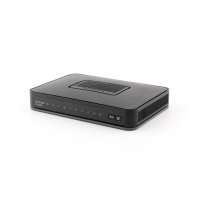
Do you have a question about the NETGEAR CG3000 and is the answer not in the manual?
Describes the LEDs and buttons on the front panel of the gateway for status and connection verification.
Details the various connections available on the rear panel of the gateway, including ports and inputs.
Outlines the four-step process for installing the voice gateway, referencing subsequent sections.
Lists the necessary prerequisites, including computer setup and cabling, before installing the gateway.
Provides step-by-step instructions for physically connecting the gateway to a computer via Ethernet.
Guides users on how to access the gateway's configuration interface via a web browser using default credentials.
Explains how to establish an internet connection and set up VoIP services, connecting phone lines.
Shows how to view network configuration and status information for the gateway's internet connection.
Explains how to set up the wireless network, either manually or using WPS, for device connectivity.
Details how to manually configure wireless network settings, including SSID and security options.
Configures wireless security using WPA or WPA2 protocols, specifying the Network Key (passphrase).
Explains how to configure WEP security, including encryption strength and passphrase or key settings.
Guides users through setting up wireless connections using the WPS button or PIN method for automatic configuration.
Describes how to view security logs and configure email alerts for events, specifying contact and SMTP server details.
Explains how to block specific keywords within URLs or entire domain names from web access for content control.
Allows disabling or enabling gateway features like Firewall, IPSec, PPTP, and various web-oriented services.
Displays hardware, firmware, and basic status information about the gateway, including network configuration details.
Shows the status of voice ports, including provision status, MAC address, IP address, and telephony signaling.
Tracks the gateway's initialization procedure and provides details on downstream and upstream cable channel status.
Guides users on how to change the default gateway login password for enhanced security.
Explains how to save and restore gateway configuration settings using a backup file for data preservation.
Logs security-related events such as denied incoming service requests and hacker probes.
Provides a tool to test network connectivity by sending ping requests to specified targets.
Configures advanced wireless radio settings, SSID broadcast, fragmentation threshold, and access control.
Specifies which wireless devices can connect based on their MAC addresses, using allow or deny lists.
Configures outbound traffic rules to block access on specific network ports for enhanced security.
Sets up inbound rules to make local servers visible to the Internet by directing traffic to specific ports.
Configures WAN settings, including DMZ address and MTU size for optimal Internet connectivity.
Enables dynamic DNS service for accessing the gateway using a domain name instead of a changing IP address.
Configures LAN IP address, subnet mask, and DHCP server settings for the local network.
Assigns a permanent IP address to a computer via DHCP reservation for consistent network access.
Allows remote configuration and status checking of the gateway via the Internet using a secure username and password.
Enables devices to automatically discover and access network resources and services, including port forwarding.
Provides initial checks and common functions to perform after powering on the gateway.
Explains how to interpret gateway LED behaviors for troubleshooting connection and status issues.
Provides steps to troubleshoot issues preventing access to the gateway's configuration interface via browser.
Guides on resolving issues where the gateway cannot access the Internet, possibly related to MAC registration.
Verifies the network path from a PC to the gateway using the ping utility, checking for connectivity.
Tests network connectivity from a PC to an external device or server, such as an ISP's DNS server.
Offers guidelines for optimal wireless signal range and performance based on gateway placement and interference.
Details the default configuration settings for the gateway, including login, network parameters, and firewall rules.